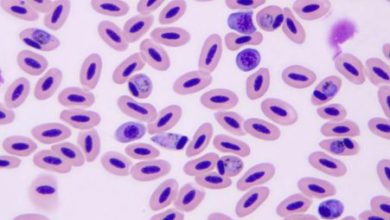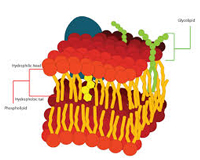Helical Virus Characteristics Examples Classification and Structure
 The word Helical Virus is derived from the Latin word Venom. Venom means poisonous fluid. Viruses can be defined as a non-cellular infectious particle that contains either RNA or DNA. It is normally enclosed in a proteinaceous coat and it reproduces only in living cells”. Viruses use the biosynthetic systems of their hosts for their own synthesis. They are then transferred to other cells.
The word Helical Virus is derived from the Latin word Venom. Venom means poisonous fluid. Viruses can be defined as a non-cellular infectious particle that contains either RNA or DNA. It is normally enclosed in a proteinaceous coat and it reproduces only in living cells”. Viruses use the biosynthetic systems of their hosts for their own synthesis. They are then transferred to other cells.
The Helical Virus was called poison during the time of Louis Pasteur (1822-1895) and Robert Koch (1843-1910). Viruses caused disease and death. The present concept of the virus has entirely changed. Now viruses are described, as particles of nucleic acid with a protein coat. They replicate in the cell and cause many diseases like influenza, hepatitis, smallpox, and AlDs. The branch of biology which deals with the study of the virus is known as Virology.
Discovery of Vaccine against Helical Virus
Viruses cause many diseases. The first vaccine was discovered against the virus. Edward Jenner vaccinated an 8-year boy in 1796. Cowpox is a viral disease of a cow. The cow develops lesions on its skin. Material (pus) was removed from this lesion on the hand of the milkmaid. Jenner used this pus for vaccination of the boy.
After 6 weeks, Jenner removed pus from the smallpox patient. He injected this pus into the boy. The boy did not develop the disease. So the boy had been successfully vaccinated. Later, Jenner used material from cowpox lesion for vaccination. He successfully vaccinated 23 persons. The cow is called Vacca in Latin. As the material for vaccination was obtained from cows or Vacca. So, Louis Pasteur used the term Vaccination.
Work of Charles Chamberland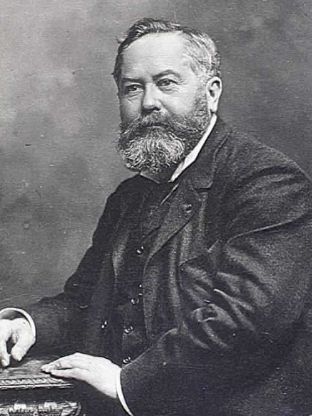
He was an associate of Pasteur. In 1884, he found that the bacteria cannot pass through porcelain filters. While Virus causing rabies can pass through these filters. Rabies is a human disease. It is transferred to humans by the biting of a rabid dog, fox, cats, bats, and other animals. In those days, people called the virus a toxic substance as it caused diseases. They described these unseen diseases causing agents as filterable viruses.
Work of Levandowski
He found in 1892 that the viruses of tobacco mosaic disease are filterable. Levandowski grounded the infected plant. He took bacteria-free filtrate from it. Levandowski placed this filtrate on the healthy leaves of tobacco. This filtrate produced disease in a healthy plant. Later, it was discovered that similar filterable ultramicroscopic viruses also caused foot and mouth disease (1898) and yellow fever (1901) in animals.
Discovery of Bacteriophage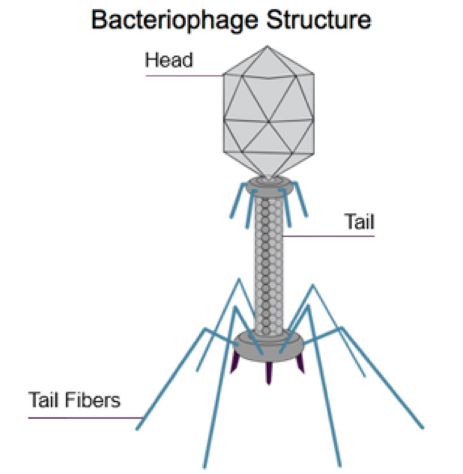
Bacteriophage or phage viruses are viruses that infect bacteria. These were independently discovered by Twort in 1915 and D’Herelle in 1917. Twort observed that sometimes, bacteria undergo lysis. During lysis, bacteria break, dissolve, and disappear. This lysis can be transferred from one colony to the other.
Even a small amount of material from this lysed colony can transfer this lysis effect. If this filtrate is heated, the lysis property is destroyed. He concluded that the lytic agent was a virus. D’Herelle rediscovered this phenomenon in 1917. He used the word Bacteriophage, for that virus. Bacteriophage means “bacteria eater”
Isolation of Virus by Stanley
Stanley purified and crystallized the filterable tobacco mosaic virus in 1935. He chemically analyzed these particles. The particle contained nucleic acid and protein. It suggests that viruses have a simple chemical composition.
Characteristics of viruses
Helical Virus show the following characteristics:
- The viruses have a very small size. Their size is less than bacteria. They are not visible under a compound microscope and can be seen only by an electron microscope.
- The size of the virus is from 250 nanometers (1nm = 10-9 meter) of poxviruses (smallpox causing virus) to 20 nm of Parvoviruses (chronic anemia causing virus).
- They are 10 to 1000 times smaller than most bacteria. So they can pass through the filter from which bacteria cannot pass.
- Viruses cannot grow on artificial med. They can reproduce in animals and plant cells or microorganisms.
- They reproduce by replication. Many copies or replicas of a virus are formed in this process.
- The viruses are obligate intercellular parasites, a parasite that cannot live without its host.
- Viruses lack metabolic machinery. So they cannot synthesize their own nucleic acid and proteins. They depend on their host cell for carrying out these functions.
- The viruses may cause disease in host cells during reproduction.
- All viruses are resistant to antibiotics like penicillin, streptomycin, and others.
- They infect only hosts and specific tissues. Tobacco Mosaic Viruses can infect only tobacco, potato, and few other plants, while Polio Virus causes disease in man, monkey, and no other animals.
Structure of Virus
The virus consists of different parts.
1. Central core
The complete viruses are called a virion. The virion is composed of the central core of nucleic acid, furthermore, this nucleic acid may be DNA or RNA. This nucleic acid is also called the genome.
2. Capsid
The Capsid forms a protein coat around the nucleic acid. So the virus is also called a nucleocapsid. The Capsid gives a definite shape to virion. The capsid is made up of a protein subunit called capsomeres. Each virus has characteristic numbers of capsomeres. For example, the Capsid of herpesviruses (causes chickenpox) has 162 capsomeres and the Capsid of adenovirus (causes the common cold) has 252 capsomeres.
3. The envelope
Some animal viruses are covered by another membrane called the envelope. This envelope is derived from the host cell. The non-enveloped viruses are called naked virions.
4. Viral Tail Fibers
In some viruses, fiber-like structures are present at the lower side known as tail fibers. These fibers help in the attachment of the virus to the body of the host.
Shape and Types of Helical Virus
Shapes of Viruses:
- PoIyhedron: having many sides.
- Helical or spiral.
- Enveloped.
- Complex.
Types of Viruses:
- Plant Viruses: These viruses attack the plants and cause many diseases.
- Animal Viruses: These viruses cause disease in men and other animals.
- Bacteriophages attack bacterial cells. They have two different structural shapes:
- Cubical Phage: They are regular solid or icosahedral (having 20 faces).
- Helical Phage: They have a rod-like shape.
Many phages consist of head and tails. The heads of these viruses are polyhedral but tails are rod-shaped.
Classification of Helical Virus
The viruses are classified on the basis of morphology and nucleic acid properties. The genetic material may be DNA or RNA. It may be naked or enveloped (by protein). It may be simple or complex. Viruses are classified into the following types on basis of their morphology: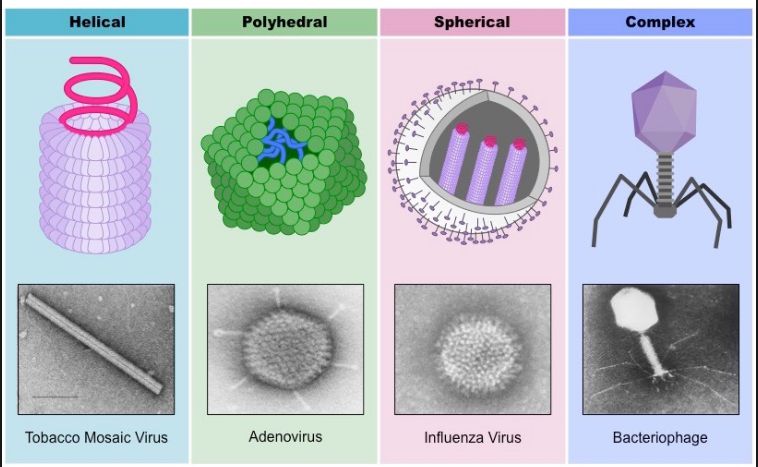
- Rod-shaped: M.V (Tobacco Mosaic Viruses)
- Spherical:
- Tadpole like:
Recent Classification of Helical Virus
The recent classification of viruses is related to their mode of origin. According to this classification, the viruses are of the following types:
- Unenveloped plus-strand RNA virus: These viruses are without enveloping. They act as m-RNA so they are plus-strand, e.g. poliovirus and Rhinovirus.
- Enveloped plus-strand RNA viruses: They also act as m-RNA. They have a lipid-rich envelope. They infect Arthropods and vertebrates called the capsid, e.g. Hepatitis A, C, and Arbovirus.
- Minus-strand RNA viruses: These viruses do not act as m-RNA. They have carried the RNA strand complementary to the m-RNA envelop called the capsid, e.g. Rhabdo virus, Paramyxovirus.
- Retrovirus: These viruses cause Aids or Hepatitis-B. In Aids, these are single-stranded RNA viruses while in Hepatitis-B these are double-stranded DNA viruses. It replicates using reverse transcriptase enzyme in host cells produce DNA from its RNA genome.
- Double stranded RNA viruses: They have double strand of RNA with capsid, e.g. Reo virus and Colorado tick fever.
- Small genome DNA viruses: These viruses contain small DNA genome. They contain envelop and capsid, e.g. Parvo virus cases Hepatitis warts in man.
- Medium-genome and large genome DNA viruses: These viruses contain medium sized or large sized genome with capsid and envelop, e.g. Herpes virus and Cancer virus.
- Bacteriophage: These viruses attack bacteria, and also they have hexagonal head and tail. In the head DNA is present, covered by capsid.
